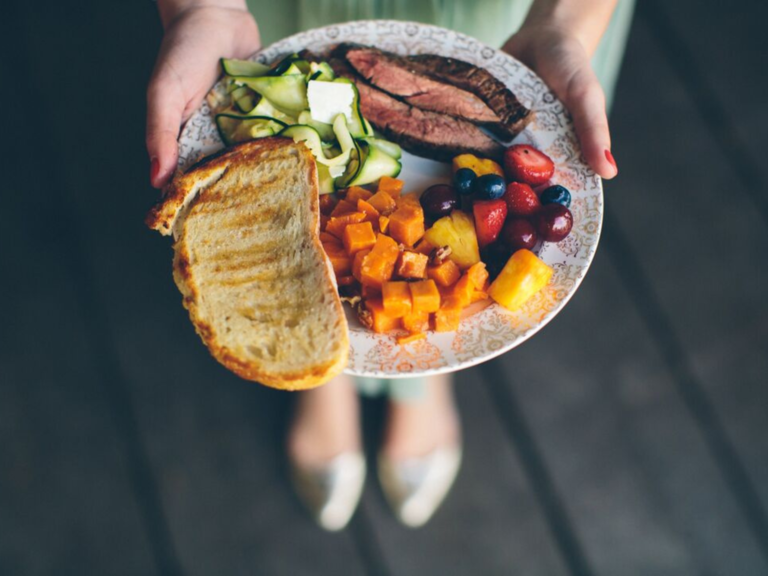Should You Have a Buffet or a Plated Meal at Your Wedding?

One of the most anticipated aspects to your wedding day by your loving guests is undoubtedly the food. There's just something celebratory about sitting down for a warm meal with your friends and family after you and your partner tie the knot. While not every single wedding involves a complete meal, the majority do—and the two most common options to choose between are a plated vs buffet wedding meal.
When planning the wedding menu with your caterer, these are two primary options that the couple considers when working alongside their caterer, explains Kevin Dennis, owner of Fantasy Sound Event Services. "With a plated meal, it tends to be a more formal affair—minimally, there will be two courses, a salad and an entree—and some couples may opt for a starter and/or a plated dessert in addition to the cake," he says. "Typically, you may have to limit to a certain number of selections, such as two protein choices and a vegetarian choice and couples will have the added task of knowing who is having what ahead of the wedding."
A buffet, on the other hand, typically involves a selection of proteins, vegetables and sides that are pre-selected in advance. "Depending on the size of the wedding, there will be one or multiple buffet lines set up, and then during the reception, each table will have time to come up and go to the buffet," Dennis says. "Sometimes, the couple may opt to serve a salad at the table and then open up the buffet."
There are other meal service options aside from plated and buffet, namely family style and cocktail style. With a family-style meal, larger platters of food are presented to the tables for guests to pass around and share. Cocktail-style meals are like extended cocktail hours, with passed bites, stationary food displays and/or interactive stations.
We're going to compare the two most common wedding meal styles—plated and buffet so you can make the call with your caterer's help. And if you haven't hired your caterer yet, it's time to get on that—check out The Knot Vendor Marketplace to find and book a caterer who can plan your menu, whether it's plated, buffet or another service style.
In this article:
- Buffet vs. Plated Meal Considerations
- Wedding Buffet Pros and Cons
- Plated Wedding Meals Pros and Cons
Buffet vs. Plated Meal Considerations
Here's a look at the differences between the two and what considerations you should make before choosing one for your big day.
Your Overall Aesthetic
When choosing between plated or buffet, Sarah Chianese, owner, planner and executive chef at Mangia and Enjoy! recommends factoring in your preferred aesthetic. Do you imagine a fancy, sit-down dinner where your guests continue their conversation while they're being served plated food—or do you imagine them getting in line to serve themself? "If it is a buffet, discuss with your caterer and design team how you can obtain a creative display and efficient ways to serve the buffet," she says. "Consider what your guest experience will ultimately be, as plated buffets have quite a different structure and atmospheric feel than plated service."



Your Caterer's Experience
When deciding on whether to have a buffet vs. plated wedding dinner, consider your caterer's experience—what do they typically serve, for how many people and to what scale? "If you have a large guest count, some caterers will advise against a buffet service, while others may suggest it," says Chianese. "It's essential to hear their reasons and ask as many questions as possible to ensure that the food service goes as the two of you wish."
Your Budget
Many people have it in their mind that a buffet is the cheaper option, however, it can often be more expensive depending on how many options you would like to host and what those selections are. "If the buffet menu is carefully selected, there can be slight cost savings, however, the caterer does tend to prepare more of each item for a buffet than for a plated dinner because they don't know how people will fill their plates, and they do not have control over portions," says Juls Sharpley, owner of Juls Sharpley Events. "The staff needed to support a buffet or stations, in most cases, is lower than that needed to execute a plated dinner, so there may be fewer servers, which could reduce labor."
Cultural Preference
As Vijay Goel, COO of Bite Catering Couture, points out, the starting point for many cultures is rooted in food rituals that may be tied to the presentation of food. "For a number of cultures, plates piled high with food on a buffet is an expectation, while, for others, a white glove service with a plated entree is the norm," he says. "Know what your guests expect and if you are playing into that expectation or consciously doing something different."
Guest Count
For guest counts over 250, Sharpley recommends opting for a buffet, mainly due to the amount of meals required to be served at the same time. "If you're offering a buffet, it's also important to consider how many stations will be available and whether they will be double-sided or single-sided, as this will impact how many stations you need and how much space to accommodate for each of these stations," she adds.
Wedding Buffet Pros and Cons
If you're leaning towards a wedding buffet, here are some of the pros and cons, according to industry experts.
Wedding Buffet Pros
There are many reasons why a wedding buffet might make sense. Here are a few.
- Self-selection for a wide range of food preferences. Since guests are able to select what they want, Goel points out that a buffet can address a number of different dietary concerns and food preferences.
- It's more casual. If you're looking for a more relaxed vibe to your wedding, a wedding buffet offers just that—in addition to leftovers for the next day!
- It may save money. It's true that a buffet may provide a cost-saving benefit, as you may need fewer food servers than when serving plated meals, notes Chianese.
- You don't need pre-selected meals. "A buffet allows you to skip the work that goes into coordinating a system for identifying who wants what and how that will be communicated," says Dennis. "Rather than risking someone being given the wrong plate, the guests are welcome to serve themselves and choose exactly what they want."
Wedding Buffet Cons
There are many reasons why a wedding buffet might be the wrong move for your big day. Here are a few.
- Your guests have to serve themselves. Some guests like this option, while others prefer not to have to get up, wait in line and serve themselves. Additionally, it's worth pointing out that a buffet line requires space, which your venue may or may not have.
- It requires added meal time. "A wedding buffet has a period of time when people are getting food and generally not paying attention to the room," says Goel. "Extra time needs to be built into the dinner portion of the reception to allow for everyone to get their food before things like speeches start."
- It may cost more. On average, a catering company usually needs to prepare 20 percent more food than a plated-style service, according to Chianese. "The couple will also need to invest in the cost of the catering company providing proper food service equipment to keep the food warm and beautifully displayed," she adds.
Plated Wedding Meals Pros and Cons
If you think you'd prefer a plated wedding meal, here are some of the pros and cons, according to industry experts.
Plated Wedding Meals Pros
Here, experts share why a plated wedding meal might be the right move for you.
- Fancier presentation: A plated dinner offers a higher-end presentation, given that a chef can finish each plate prior to it being sent for service, explains Goel. "The use of service staff delivering the plate to the table, potentially synchronized, offers a service level that can approach Michelin levels for luxury weddings," he adds.
- It may be more affordable: Some catering companies provide plated service at a lower rate, according to Chianese. This, she explains, is because the caterer knows precisely how much food to order to satisfy the menu.
- There's less food waste: For couples who share an ethic, embracing sustainability, plated service is a huge benefit. There is little to no food waste when it comes to plated service, and the couple should discuss this goal with their caterer if they are fervent in their quest for sustainable methods.
Plated Wedding Meals Cons
Here are some reasons why a plated wedding meal might not be the right move for your big day.
- Guests can't choose portion size: Some guests are hungrier than others; or simply eat more. "Unless you make arrangements with your caterer beforehand, some guests may leave the table hungry if the portions are not large enough," says Chianese.
- It can take a while to plate every guest: "Even the most efficient teams will take between 90 minutes and two hours to serve a three-course meal to average guest counts," explains Sharpley. "This also takes into consideration that you likely have special moments throughout the meal, such as toasts, blessings and possibly your special dances."
- It can be more expensive: Sometimes the wedding buffet is even more costly than a plated dinner because the catering company needs to prepare more food. This surge in cost is often unexpected by the couple, which can be upsetting if they're not told upfront.




















